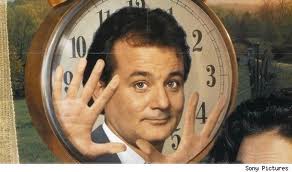“It’s Groundhog Day!”
(We’ll get to Gobbler’s Knob in a moment.)
Today—February 2nd—is a big turning point. It’s a great cross-quarter day, midway between the Winter Solstice and the Spring Equinox. In ancient, agricultural societies it was regarded as the beginning of spring—the time for first turning the soil in preparation for March planting. There were prayers and rituals centered on the fertility of the earth.
Imbolc was the pagan Gaelic name for February 2nd, and the Roman Catholic Church (as it always does so well) appropriated the pagan festival and renamed it Candlemas. On February 2nd priests would bless candles and distribute them to the people, who burned them in every window of their homes. It expressed a great yearning for the light, for spring, for fertility, growth and sustenance.
If you’re focused on the earth and praying for its fecundity, it makes sense that these people would be into weather divination. That’s where the groundhog comes in (or out, depending . . . ). As an old English song put it:
If Candlemas be fair and bright,
Winter has another flight.
If Candlemas brings clouds and rain,
Winter will not come again.
They wanted a cloudy, rainy warmish day, not a clear, bright-cold one. If the groundhog peeked out and the sun cast a shadow, it was back in the hole. Six more weeks of winter.
There is a modern tradition associated with this day. It’s a cinematic ritual. People watch Bill Murray’s classic, Groundhog Day. I do, anyway. In its own, quirky way the film depicts a man who is caught at just that turning point between the light and the darkness. Bill Murray is a big “personality” TV weatherman, the Willard Scott of Pittsburgh. For the umpteenth year in a row he’s assigned to cover Groundhog Day on location in Punxsutawney, PA, and this small-town cornball affair is decidedly beneath him.
But he does it. And when he wakes up the next morning he is still in Punxsutawney and it’s Groundhog Day all over again. And again and again and again.
He might as well be scaling the seven terraces of Dante’s Purgatory, or undergoing a thousand karmic reincarnations. He keeps living each day in pride and arrogance, or rank hedonism, or despair and nihilism, and he suffers accordingly. Standing at that fulcrum point between a solstice and an equinox, he is drawn by the light and pulled by the darkness. Day after day he cooperates with the darkness. Finally he learns to cooperate with the light, to allow himself to be pulled into its luminous heat, surrender to its benign power.
This is a good day to stand in the light, lean into it, cooperate with its pull. Light a candle or twenty candles. If (like me) you have been too busy to take down the Christmas lights outside on three evergreens, turn the lights on. I have not lit those trees in weeks for fear of the neighbors: Doesn’t that Anderson guy know it’s not Christmas anymore? Who gives a socket? I’m lighting them all day today. They’re Epiphany lights, Candlemas lights, Punxsutawney lights.

Growing up in Minnesota, I thought ONLY 6 more weeks of winter was the better case scenario! And the clear, cold days of January were at least sunny. By mid February, the gray cloudy days of snow – day after day – taxed the soul so much more. When spring arrived, every year, I was always startled – genuinely surprised that I could be warm again!
Yes, this South Dakota boy has similar memories–“genuinely surprised that I could be warm again!”
Hi David The Weather forcst looks good If I remeber yesterdy correctly! Blessings clark
Love this one – look into the LIGHT! Will do. Ginny
You are so faithful David. But Geez Louis, I never knew there was all of that deep philosophical stuff in the movie Ground Hog Day. I thought it was just a silly Bill Murray B- movie!
Keep thinking deep thoughts.